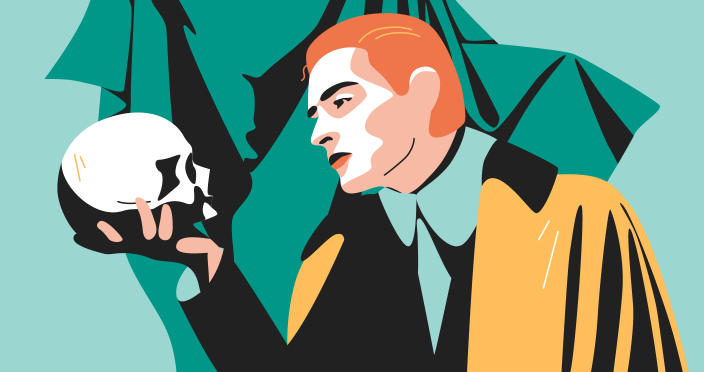What type of play is Hamlet? You are likely to experience some troubles with defining it. Don’t worry! On this page, our experts explored Hamlet’s genre, tone, and literary devices.
⚔️ What Genre Is Hamlet?
By its genre, Hamlet is a revenge tragedy. It is the genre of literature where the dominant motive is to take revenge for a wrong action done to the main character or their family. Revenge tragedies were exceptionally popular in England in the 1580s-1600s.
Let’s dive deeper and explore the general elements of tragedy in Hamlet:
A Play Within a Play

Typically, a revenge tragedy includes another play in its plot that is somehow connected to the main story. In Hamlet, play-within-a-play is also present.
The troupe arrives at the castle. The actors perform the play about Gonzago and his wife, Baptista, who marries his murdering nephew, Lucianus. This performance plays a crucial role since it helps Prince reveal the truth about Claudius’s murder.
Scenes of Madness
Insane heroes and scenes are common for revenge tragedies. Shakespeare masterfully introduces this element in Hamlet as madness affects various characters under different circumstances.
Throughout the play, Prince pretends to be insane. His intense monologues full of “wild and whirling words” (Act 1, Scene 5) add extra value to the tragedy of Hamlet and keep the readers intrigued.
Besides Hamlet’s hysteria, Shakespeare introduces more madness in his revenge tragedy through other characters. For example, Ophelia loses her mind when she learns about her father’s death. Being too desperate and frustrated, she commits suicide. Moreover, Laertes openly rages at Hamlet and seeks to avenge Polonius’s murder.
Vengeful Ghost
Another element of revenge tragedies is the appearance of a vengeful spirit. In Hamlet, the Ghost of Old King occurs in the very first scene. When he stays one-on-one with Hamlet, it orders Prince to avenge Claudius for the King’s death. Thus, Shakespeare depicts Hamlet as a revenge tragedy by introducing the character of the Ghost in the play.
Desire for Vengeance
An essential element of any revenge tragedy is a central character with a serious intention to avenge someone’s death. This play is entirely built on the theme of revenge. The protagonist Hamlet is a tragic hero who desires to avenge his uncle Claudius for his father’s death.
So, is Hamlet a tragedy? Yes, as it includes many mad scenes, play-within-a-play, vengeful spirit, and a revenge ending.
🤴 How Hamlet Is a Tragic Hero
According to Aristotle’s Poetics, a tragic hero is a virtuous character in a dramatic play who is destined for suffering or downfall caused by an error of judgment. Usually, his purpose as a literary device is to evoke pity in an audience.
So, is Hamlet a tragic hero, according to Aristotle?

Throughout the entire play, Prince goes through a series of challenges and sufferings. He is an honorable man, yet his misfortune leads him to his inevitable demise. Thus, Hamlet as a Shakespearean tragic hero perfectly fits Aristotle’s definition.
Hamlet’s tragic flaw is his indecisiveness. Instead of killing Claudius immediately, Prince hesitates. He is unsure about the reliability of the Ghost’s words. Hamlet decides to investigate this case himself to be confident of Claudius’s villainy. When his hesitation reaches its peak, he is unable to make weighted decisions. Hamlet becomes too impulsive, which leads to irrational actions and numerous deaths.
⚱️ Why Hamlet Is a Unique Tragedy
William Shakespeare introduced many modifications to his tragedies, which distinguish his works from typical revenge tragedies in the Jacobean period. Let’s take a look at some of the innovations that Shakespeare enriched Hamlet with.
Indecisive Protagonist
Some call Hamlet a ‘procrastinating prince’ because of his indecisiveness and a certain passivity. In the classic revenge tragedy, after the murder of a relative, the hero usually takes all measures to commit righteous vengeance. “An eye for an eye, a life for a life” exemplifies the crux point of the matter in revenge tragedies. However, Hamlet avoids the role of an avenger in every possible way, and as a result of his indecision, other people die. The tragedy is not so much in the death of the Danish king but in the subsequent events unfolding after his death. In particular, in the gloomy thoughts of Hamlet that grip his mind and soul.
Shakespeare relies on the complexity of his protagonist’s personality and thoughts. It is sometimes challenging to understand Hamlet’s real motives because he rushes between what he should do and what he wants. The gap between the two leads Prince to depression. He is confused; he does not know what is right and what is not. Add to this list the pain because of a father’s death and the distress caused by a mother’s strange remarriage, and you have the ideal psychotherapist client. It is a pity that there were no such doctors in Shakespeare’s time.
Is Suicide a Solution?
A typical revenge tragedy has only one right plan of action – to seek vengeance. However, Shakespeare goes beyond the frames and introduces one more option to Hamlet. Prince contemplates committing suicide to get rid of all the problems at once. But is it a reasonable decision? Hamlet analyzes the essence of life. He realizes that the uncertainty of what happens after death scares him even more than revenge.
Humor in the Play
Even though Hamlet is a revenge tragedy by its genre, Shakespeare adds humor to the play. Prince sees right through people and accurately defines their intentions. Therefore, the readers can notice that he sometimes talks caustically and satirically to Claudius. If we observe Hamlet’s attitude to Polonius, Osric, Rosencrantz, and Guildenstern, we can see that he is playful and contemptuous towards them. Hamlet’s unfailing humor proves his sanity to the reader because humor and madness do not travel the same road.
Since Shakespeare added humor, sometimes people question the play’s genre. Is Hamlet a tragedy or comedy? The best way to define its genre is to say that it is a revenge tragedy with comic elements.
“Right” vs. “Wrong” Avengers
Laertes, Ophelia’s brother, loses his father just like Hamlet did. But unlike Prince, he strives to make retribution without any introspection. Laertes personifies the canonical avenger – a resolute hero with a hot temperament. Despite the canonicity of this personality, Shakespeare subtly ridicules the character. His apparent decisiveness turns into stupidity. If Laertes had spent more time sorting out the causes of his father’s death, he would have realized that Polonius was primarily responsible for his fatal ending.
Shakespeare plays on contrasts, comparing indecisive Hamlet and impetuous Laertes. Ultimately, the author shows the devastating consequences of the vices of both characters and teaches the viewer the rule of the golden mean.
🔖 Literary Devices in Hamlet
To make Hamlet intriguing and immersive, Shakespeare used several literary devices in the play. The following section will help you explore them.
Where is Hamlet set?
The action takes place in Denmark. The castle of Elsinore becomes the primary location for the whole play. Only Act 5 Scene 1 takes place outside, on the cemetery not far from the court.
As we can understand from the plot, Elsinore has a lot of private spaces. For example, Hamlet often delivers his soliloquies alone, Ophelia and Gertrude have their private closets, and Claudius prays in the private chapel. Yet, ironically, Hamlet’s privacy is often violated since his uncle spies upon him every time he has a chance to do so.
Thus, by contrasting Elsinore’s abundance of private spaces and a lack of Prince’s privacy, Shakespeare highlights the atmosphere of mistrust and uncertainty in the play.
When does Hamlet take place?
The play is set in the late middle ages (sometime around 14th and 15th centuries). However, Hamlet reflects the events that were happening in England at the beginning of the 17th century. During that time, Protestant Reformation occurred and brought a new branch of religion to England. In the play, Shakespeare vividly depicts the confrontation between Catholicism and Protestantism. Therefore, Hamlet becomes a representation of 17th century England to some extent.
What’s Hamlet’s tone?

The entire play is written in a dark and uncertain tone. A dark veil covers Elsinore when Old Hamlet dies, and the Ghost appears. Prince’s never-ending doubts and hesitation create an atmosphere of uncertainty and ambiguity. The depressive mood reaches its peak at the end of the play when the readers observe numerous merciless deaths.
What’s the point of view in the play?
The narrative perspective of Hamlet uses a strictly limited third-person voice. In the play, the author is not a part of the story. Moreover, there is no narrator or any other story-telling voice. All the action of the play is presented via dialogue and interactions between the characters.
Since the narrator is absent, the author has no chance to provide his personal evaluation of the situation. The readers have complete freedom to interpret each scene in the way they feel is the most appropriate one.
What are some motifs in Hamlet?
There are three key motifs in the play:
- Incest. Gertrude marries her brother-in-law Claudius. This is the most vivid example of incestuous desire in the play. However, there are more hidden instances as Laertes sometimes speaks to Ophelia using suggestively sexual terms. Moreover, Hamlet is preoccupied with Gertrude’s sex life with Claudius.
- Misogyny. In Shakspeare’s times, women did not have rights. This is explicitly depicted in Hamlet. In the play, men use Ophelia and Gertrude for their benefit. In addition, Hamlet’s hatred towards his mother arises when he learns about Gertrude’s new marriage and, consequently, spreads to all the women.
What are some allusions in Hamlet?
Shakespeare introduces a significant number of allusions in the play. You can find examples of them below:
Hyperion: a superhuman in Greek mythology. He ruled the world before Olympian gods came into governance.
So excellent a king, that was to this Hyperion to a satyr.
Hamlet, Hamlet, Act I, Scene 2
Hercules: a Roman mythological hero with immense strength.
My father’s brother, but no more like my father
Hamlet, Hamlet, Act I, Scene 2
Than I to Hercules.
Trojan Horse: a horse from the Roman epic poem The Aeneid.
When he lay couchèd in the ominous horse.
Hamlet, Hamlet, Act II, Scene 2
📜 Hamlet: Soliloquies
📌 What is the purpose of a soliloquy?
A soliloquy is a speech usually presented by one actor on the stage. It underlies candid emotional self-talk given aloud. Soliloquies aim to reveal the character’s deepest emotions and thoughts. They help the audience to notice details that otherwise may be left overlooked. Additionally, soliloquies raise an intimate atmosphere that the author wants the audience to experience in specific scenes.
📌 Soliloquy vs. aside – what’s the difference?
Even though soliloquy and aside share numerous features, they should not be confused. The main difference relates to their length. While soliloquies are typically long speeches, asides represent short remarks. Asides are capable of revealing one specific character or detail. Soliloquies express a broader and more complex collection of emotions.
Questions like “What is the purpose of a soliloquy in Hamlet?” may naturally arise due to their heavy use in the tragedy. Shakespeare relies on this literary device at least seven times throughout the play. He uses soliloquies to reflect the situation and the significance of the character’s feelings. They intensify the tone of the scenes and help to move the plot forward.
For example, Hamlet’s first soliloquy in Act 1 Scene 2, unfolds the rising action, informing the audience about the exigent problem. This monologue transmits the gloomy atmosphere that reigns in Prince’s innermost thoughts because of his mother’s upcoming marriage. He manifests himself as a miserable, wounded soul and even questions the worth of living. The first soliloquy sows the seeds of tension that the audience anticipates dispelling further.
The soliloquy in Act 2 Scene 2 thickens the clouds of Hamlet’s musing. It reveals his true tragedy – the impossibility to exact revenge due to the heir’s fearful nature: “Am I a coward?” Prince gets heart-struck as he stumbles upon the details of his father’s death. The fact that Claudius has murdered King Hamlet makes the protagonist hate his uncle even more.
The most prominent Hamlet’s soliloquy in Act 3 Scene 1 is widely recognized by the only phrase “To be or not to be?” This lasting question personifies the burden of heavy thoughts that prevents him from taking action. Hamlet’s fourth soliloquy finally establishes his character as rather a thinker than a doer. Overthinking poisons his life and puts the promise the son gave to the father at risk. The young man raises the question of the nobility of those ready to lay heads for justice. What is interesting, Act 3 also presents Claudius’ soliloquy that confirms his involvement in the murder. It gives another incentive to the plot development and makes the audience anticipate the rightful fall of the villain.
A dramatic shift from apathy to action happens in the final Hamlet’s soliloquy in Act 4 Scene 4. Prince eventually decides to avenge his father. Although the protagonist still contemplates mortality, he is ready to die to establish justice.
All soliloquies portray Hamlet as he is with all his flaws and despondency. Shakespeare skillfully intertwines soliloquies and regular dialogs. He thus makes the audience feel the depth of grief and resentment the character condemns himself to.
Thanks for reading the article! If you’re looking for more information about the play, check the links below.
